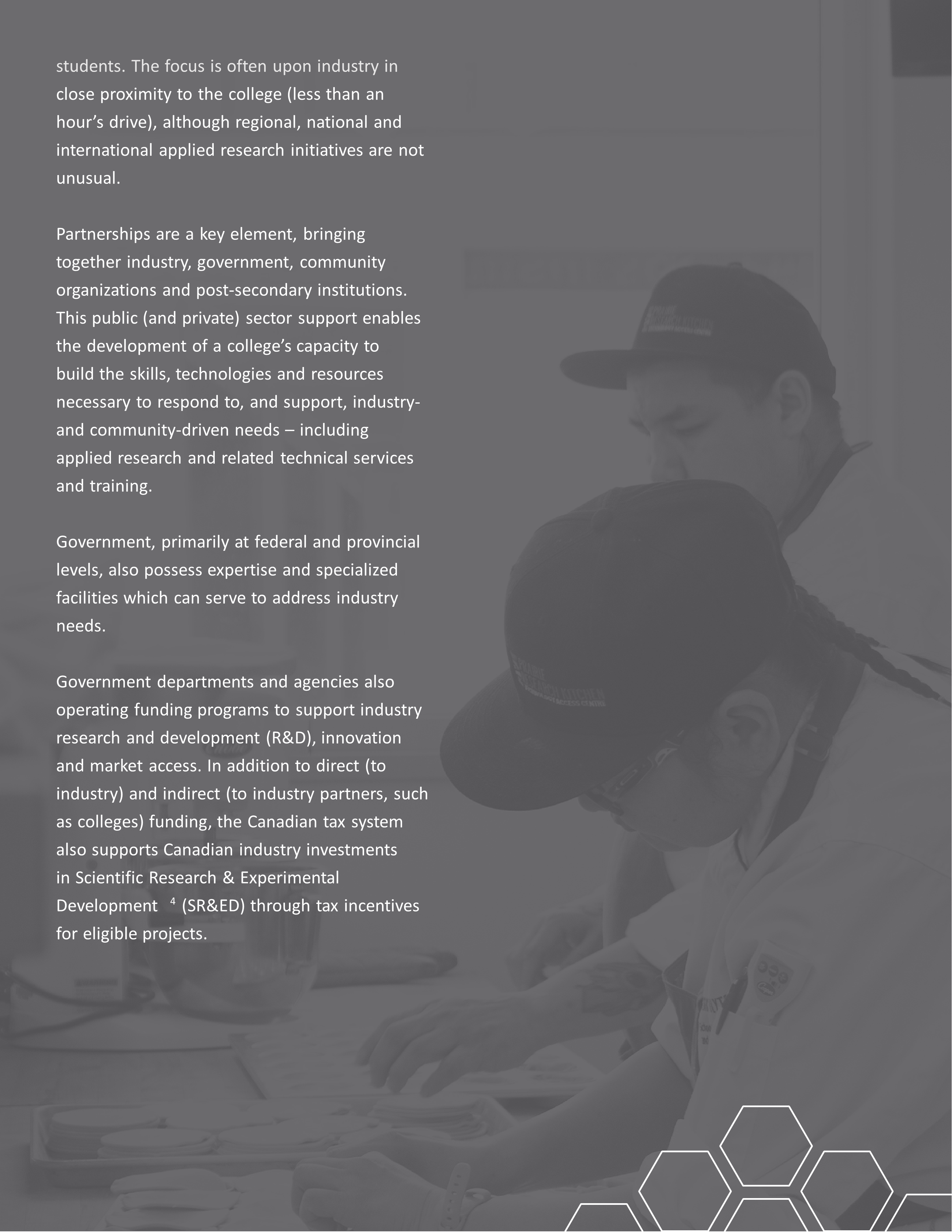CANADIAN COLLEGE APPLIED RESEARCH: A GUIDE FOR INDUSTRY!
TABLE OF CONTENTS
| EXECUTIVE SUMMARY | 3 |
| PREAMBLE | 4 |
| EVOLUTION/HISTORY OF COLLEGE APPLIED RESEARCH | 6 |
| WHAT IS APPLIED RESEARCH? | 8 |
| HOW TO ENGAGE IN COLLEGE APPLIED RESEARCH | 12 |
| PROJECT EXAMPLE: ADVANCED DESIGN & MANUFACTURING | 14 |
| FAQS | 18 |
| ACRONYMS | 33 |
| PHOTO CREDITS | 34 |
| BIBLIOGRAPHY | 35 |
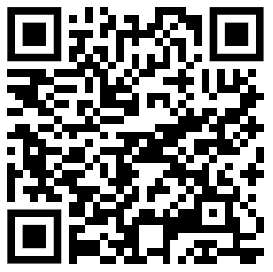
Short Link : https://tech-access.ca/TAC-CCARGuide/
- Ray Hoemsen, P. Eng, President and Managing
- Director of NEXUS Manitoba, and
- Ken Doyle, Executive Director of Tech-Access Canada
EXECUTIVE SUMMARY
Through applied research, Canadian colleges can help industry get their ideas to market. This Guide will help those in industry not familiar with applied research in Canadian colleges.

College applied research can add value for an industry client or partner by addressing short-term company-specific needs through the application of knowledge and/or the application and adaption of technology; supporting industry innovation, productivity and competitiveness. Industry-friendly intellectual property (IP) practices maximize commercial potential through maintained or increased domestic and export sales; while supporting jobs in the community.
Since the turn of the 21st Century, applied research in the Canadian college system has evolved from an ad hoc “side of the desk” activity to structured programs enabling the college to provide knowledge and expertise, as well as access to specialized equipment and facilities. Community economic development is a key driver of college applied research. Partnerships are a key element, bringing together industry, government, community organizations and post-secondary institutions.
“Applied Research” is generally considered to be the application of knowledge and/or the application/adaption of technology to resolve an (often industry) need or problem with the objective of delivering a satisfactory resolution or result; complementing “basic” or “discovery” research which adds to the global body of knowledge about a particular subject. In colleges, the focus is more on the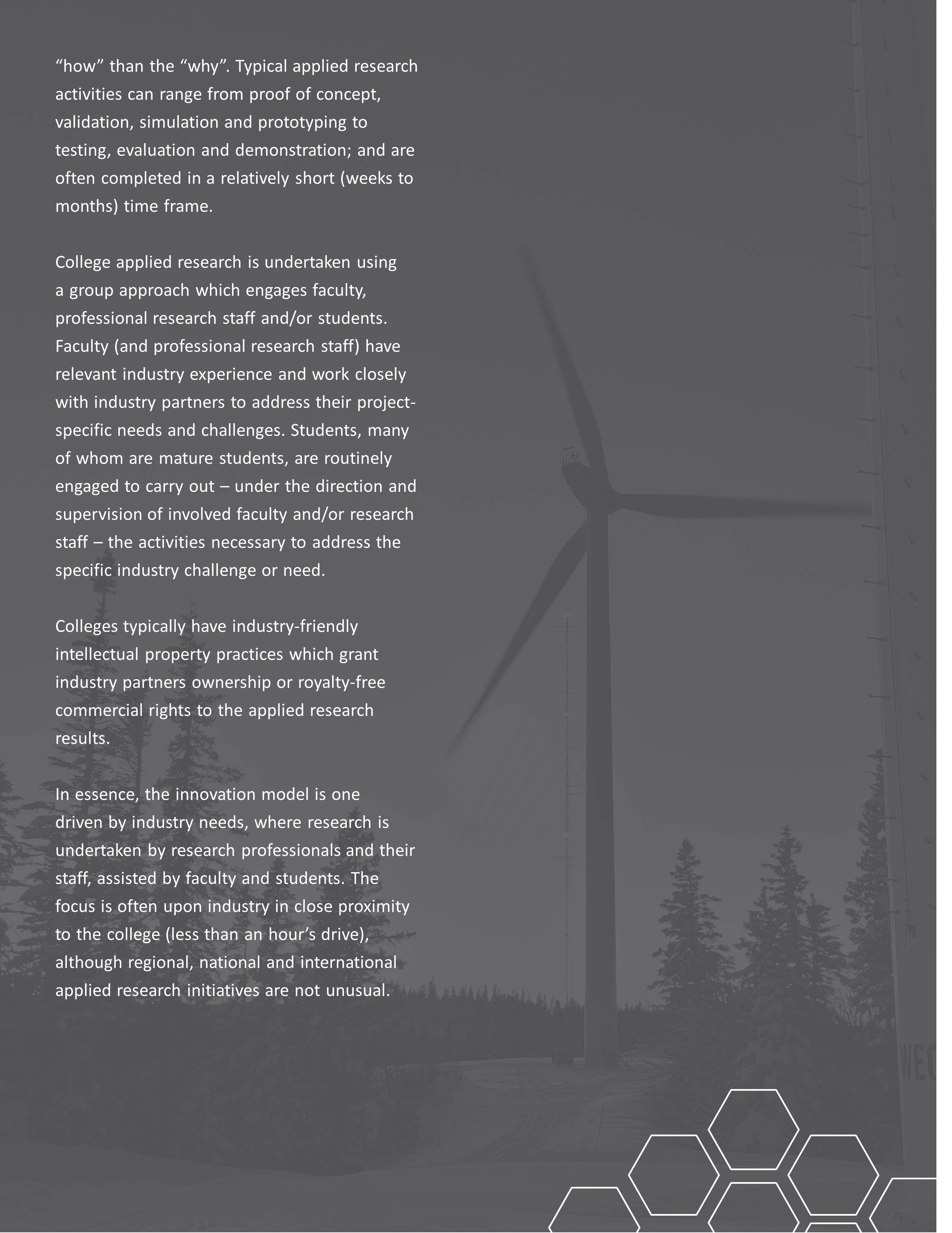
PREAMBLE
This paper was developed in 2022 by Ray Hoemsen, P. Eng, President and Managing Director of NEXUS Manitoba, and Ken Doyle, Executive Director of Tech-Access Canada. The authors have more than 40 years of experience in Canadian college applied research. TechAccess Canada greatly acknowledges the funding support from eCampusOntario1 to make this guide a reality.
This Guide has been prepared by TechAccess Canada2, to help those in Ontariobased industry striving to bring their idea to market; and who are seeking applied research assistance from a Canadian college for the first time.
The Frequently Asked Questions (FAQs) and Project Example, which are based on several decades of experience in the college applied research environment, will address most questions by prospective industry clients or partners. However, individual colleges will have approaches which reflect their policies, procedures, practices and culture.
EVOLUTION/HISTORY OF COLLEGE APPLIED RESEARCH
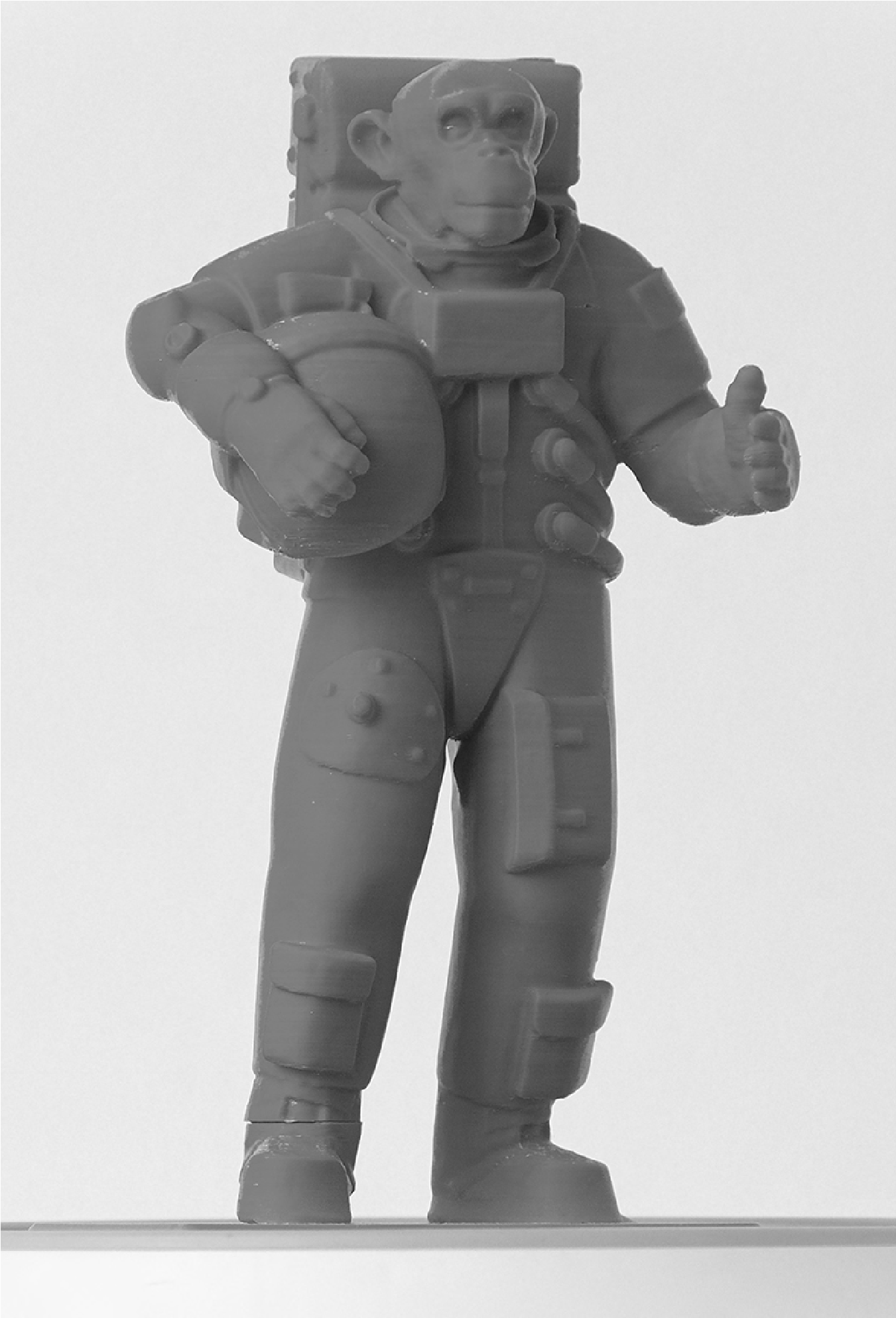 |
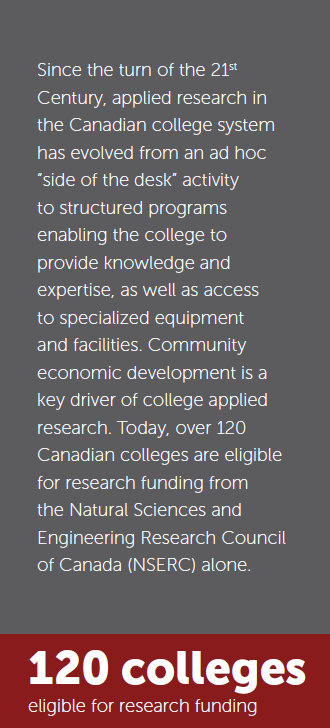 |
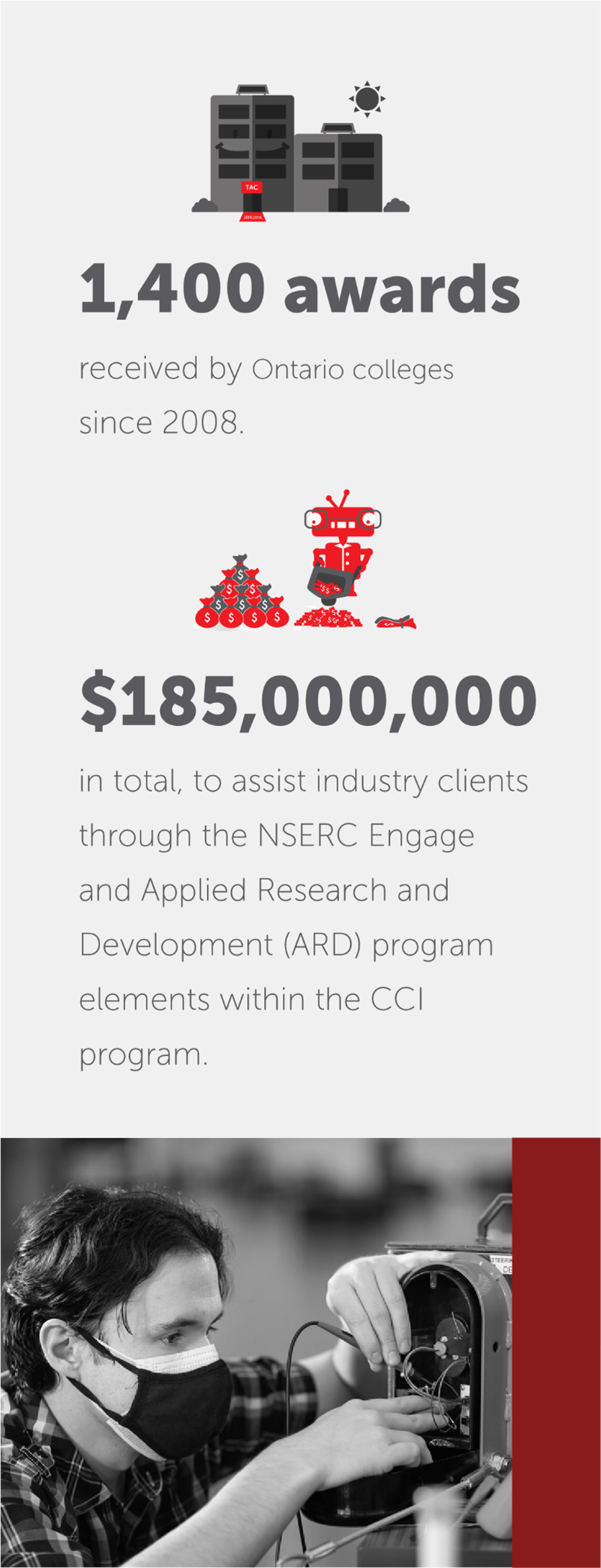
The Government of Canada established permanent applied research funding programs for the college sector in 2008, following a pilot program delivered by NSERC. Since the establishment of the permanent College and Community Innovation (CCI) program, which is delivered by NSERC along with the Social Sciences and Humanities Research Council (SSHRC) and the Canadian Institutes of Health Research (CIHR).
In 2010, the Canada Foundation for Innovation launched the College-Industry Innovation Fund to support colleges with state-of-the-art, industry-relevant research infrastructure.
CCI funding is intended to support applied research partnerships with industry, especially Small and Medium-sized Enterprises (SMEs).
Colleges that have built strong capacity and capability in a specific area of innovation expertise can compete for a Technology Access Centre award, the national designation of excellence for college applied research centres.
Since 2008, Ontario colleges have received nearly 1,400 awards, totalling over $185,000,000 to assist industry clients through the NSERC Engage and Applied Research and Development (ARD) program elements within the CCI program3.
Other federal and provincial departments and agencies offer support for applied research projects and services. For example, the National Research Council of Canada (NRC) through its Industrial Research Assistance Program (IRAP) will enter into “Contribution to Organization” (CTO) agreements with colleges to provide technical and/or business services to support applied research needs of Small- and Medium-sized Enterprises.
WHAT IS APPLIED RESEARCH?
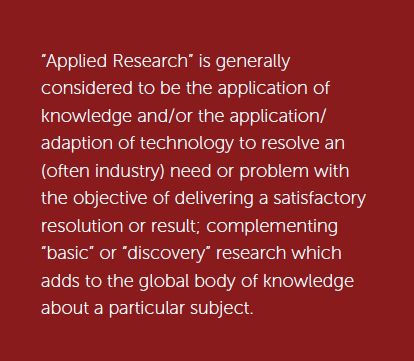 |
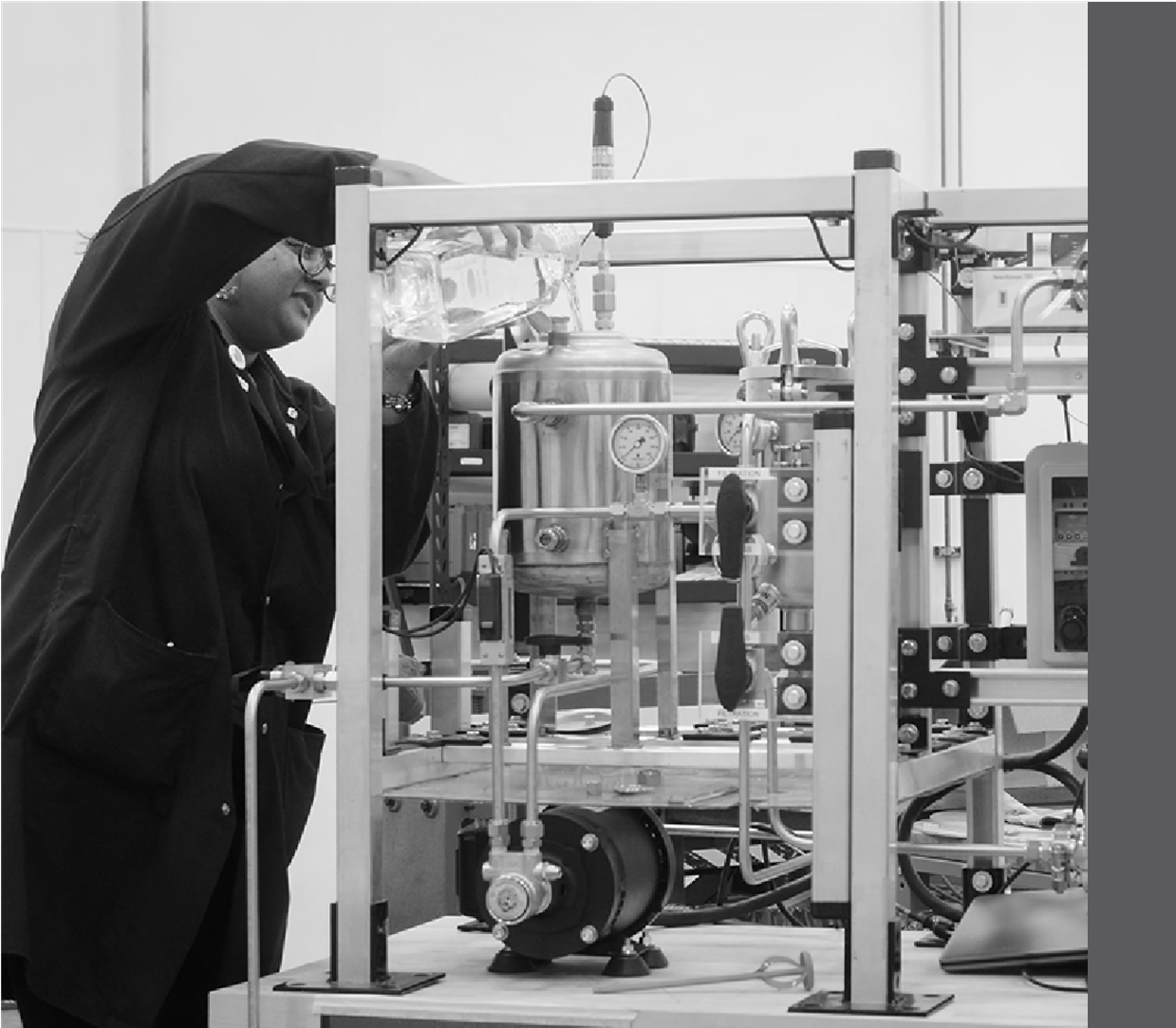 |
Applied research requires the ability to problem solve, apply knowledge and/or apply/adapt technology. Key activities are Proof of Concept | Validation | Simulation | Prototyping | Testing | Evaluation | Demonstration.
While both universities and colleges are engaged in applied research, the primary focus of university researchers is basic or discovery research.
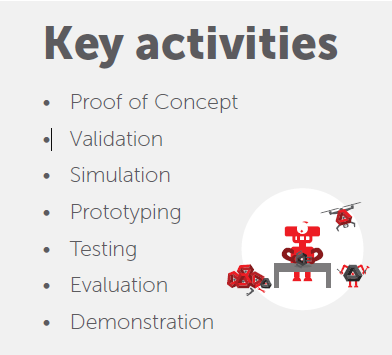 |
Colleges are driven by the needs of their community and, through the delivery of education, training and (over the last 20 years of so) applied research, support community economic development. By addressing the needs of industry through the provision of educated graduates for the workforce, retraining of existing employees and now as a resource for industry-relevant applied research, colleges help industry to stay in business and thrive.
Table 1 illustrates the complementary nature of college and university research.
| FACTOR | UNIVERSITY | COLLEGE |
| Nature of Research | Discovery (Basic) | Applied |
| Expectation (of Government funders) | Create Knowledge | Increase Productivity, Competitiveness, Jobs & Exports |
| Knowledge | Advancement | Application |
| Focus | Why? | How? |
| Term | Medium-Long | Short |
| Motivation | Curiosity | Client |
| Approach | Principal Investigator | Group |
| Driver | Technology Push | Market Pull |
| IP Ownership | Creator or Shared | Institution, Freely Shared |
| Mechanism | License or Spinoff | Sponsor Agreement |
| Technology | Commercialization | Diffusion |
| Impact | Benefit to Society | Economic Development |
Table 1: Research & Innovation Attributes of Colleges & Universities

In colleges, the focus is more on the “how” than the “why”
 In colleges, the focus is more on the “how” than the “why”; in other words – HOW to solve the specific client (demand) driven challenge/ problem/need through the adoption/adaption of technology and/or the application of knowledge. Typical applied research activities can range from proof of concept, validation, simulation and prototyping to testing, evaluation and demonstration; and are often completed in a relatively short time frame (weeks to months). College applied research uses a group approach which engages faculty, professional research staff and/or students. Faculty (and professional research staff) have relevant industry experience and work closely with industry partners to address their projectspecific needs and challenges. Students, many of whom are mature students, are routinely engaged to carry out – under the direction and supervision of involved faculty and/or research staff – the activities necessary to address the specific industry challenge or need.
In colleges, the focus is more on the “how” than the “why”; in other words – HOW to solve the specific client (demand) driven challenge/ problem/need through the adoption/adaption of technology and/or the application of knowledge. Typical applied research activities can range from proof of concept, validation, simulation and prototyping to testing, evaluation and demonstration; and are often completed in a relatively short time frame (weeks to months). College applied research uses a group approach which engages faculty, professional research staff and/or students. Faculty (and professional research staff) have relevant industry experience and work closely with industry partners to address their projectspecific needs and challenges. Students, many of whom are mature students, are routinely engaged to carry out – under the direction and supervision of involved faculty and/or research staff – the activities necessary to address the specific industry challenge or need.
The driver for college applied research is “market pull”, more so than “technology push”, i.e., finding a solution to a problem, rather than finding an existing problem for a new discovery.
Colleges typically have industry-friendly intellectual property practices which grant industry partners ownership or royalty-free commercial rights to the collaborative applied research results. This approach enables industry to immediately apply the applied research results to their product, process or service idea and get to market in a timely manner since IP rights are clear and have been dealt with up front with a minimum (if any) amount of negotiation.
In essence, the innovation model is one driven by industry needs, where research is undertaken by research professionals and their staff, assisted by college faculty and
HOW TO ENGAGE IN COLLEGE APPLIED RESEARCH
College applied research can add value for an industry partner by addressing shortterm company-specific needs through the application of knowledge and/or the application and adaption of technology; supporting industry innovation, productivity and competitiveness. Industry-friendly intellectual property practices maximize commercial potential through maintained or increased domestic and export sales, while supporting jobs in the community. 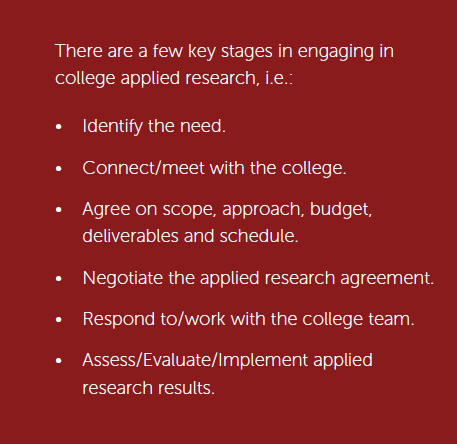
If a potential industry client or partner wants to engage with a college to address a specific need or challenge, the key (and sometimes hardest) first step is defining that need or challenge. This will help to determine what exactly needs to be done. The college can also work with the industry client on this “problem definition”.
Most colleges have an applied research, innovation and/or partnerships department, otherwise the business development department is also a good place for industry to initially connect with the college. If industry knows a faculty or staff member at the college, that individual can also direct industry to the applied research department.
An initial meeting can then be held to discuss the industry need, while at the same time discuss the capabilities of the college, in order to determine if there is a “fit”. It is not unusual for a Non-Disclosure Agreement (NDA) to be signed at this stage, especially if industry has any concerns with respect to confidentiality and proprietary information.
The next stage is to exchange information to enable the college to determine the scope, approach, budget, deliverables and schedule. The project plan may incorporate “GO” “NO GO” decision points. The college will also determine which key faculty and/or staff who will be involved in the applied research, industry should identify a key technical contact to liaise/work with the college, as needed. The college may also identify, and apply for, government funding to support the applied research project.
 Once industry and the college have agreed upon the statement-of-work, then an applied research agreement can be negotiated. This agreement will address the key elements of the statement of work, as well as terms concerning confidentiality, publication, intellectual property, warranty, indemnity, financial terms etc.
Once industry and the college have agreed upon the statement-of-work, then an applied research agreement can be negotiated. This agreement will address the key elements of the statement of work, as well as terms concerning confidentiality, publication, intellectual property, warranty, indemnity, financial terms etc.
As the applied research work is being carried out, regular communication between the college and industry is essential, as is responsiveness to requests for information and feedback. An industry partner cannot simply “throw the challenge over the wall” to the college, cease interaction and expect a positive result on budget and on time. While there is no need to meet simply for the sake of meeting responding to requests for input and clarification is a “must do” for all parties.
Upon completion of the project, industry will be in the best position to assess and evaluate the applied research results and make a decision with respect to implementation.
PROJECT EXAMPLE: ADVANCED DESIGN & MANUFACTURING
 Identify the need
Identify the need
A local manufacturer of rotating equipment was still able to produce their legacy product, but the design was several years old and detailed blueprints no longer existed. As a result, there was a limited ability to make design improvements in order to improve product durability and performance (which could only be addressed through trial-and-error and field tests – computer modelling and simulation were not an option). The requirement to operate in extreme climatic conditions (-40°C to +50°C) was a further complication. Fabrication problems resulted in variability in quality (evidenced by a relatively high level of deviation requests, change orders, rework and scrap), excessive fabrication and assembly times, and difficulty in implementing design improvements. These manufacturing issues increased cost, while the challenges in the development of design improvements limited the manufacturer’s ability to respond to new market opportunities.
 Connect/meet with the college
Connect/meet with the college
The company was referred to the local college by a government contact. The applied research office identified their Technology Access Centre (TAC), which specialized in advanced design and manufacturing, as potentially having the personnel and specialized research equipment and facilities to assist the manufacturer.
The company and college met, initiated a relationship and discussed the history of the company, the product and specific challenges; while the college identified their relevant expertise, facilities and capabilities.
 Assess/Evaluate/Implement applied research results
Assess/Evaluate/Implement applied research results
Specialized equipment – such as a handheld laser inspection device, digital input to computer aided design (CAD) modelling software, analytical software, access to 3D metal printer – was required to perform the necessary applied research. These capabilities, along with the necessary knowledge and expertise, were integrated within the college’s TAC. Once it was determined that there were no privatesector providers in the region capable of providing the needed resources, the company asked the TAC to develop an applied research proposal.
A statement-of-work was developed, which addressed project scope, budget, schedule and deliverables. To digitize the existing product, create a CAD model, use the appropriate software to analyze the design within company-supplied operating parameters and recommend a process to improve manufacturability would require a total investment of $30,000 (cash) for salaries ($15,000), a faculty course release ($7,500), materials & supplies – including the appropriate software license ($1,500), facility utilization ($1,000), and overhead ($5,000). The company was also asked to provide samples of all parts for their product, including operating manuals and related documentation.
The college planned to hire a student research assistant, supervised by a faculty member, working with a dedicated research professional skilled in computer modelling, simulation and analysis to carry out, on a “best effort” basis, the applied research project over a four-month period. The deliverables would include a set of digitized blueprints and a final project report.
Details of costs
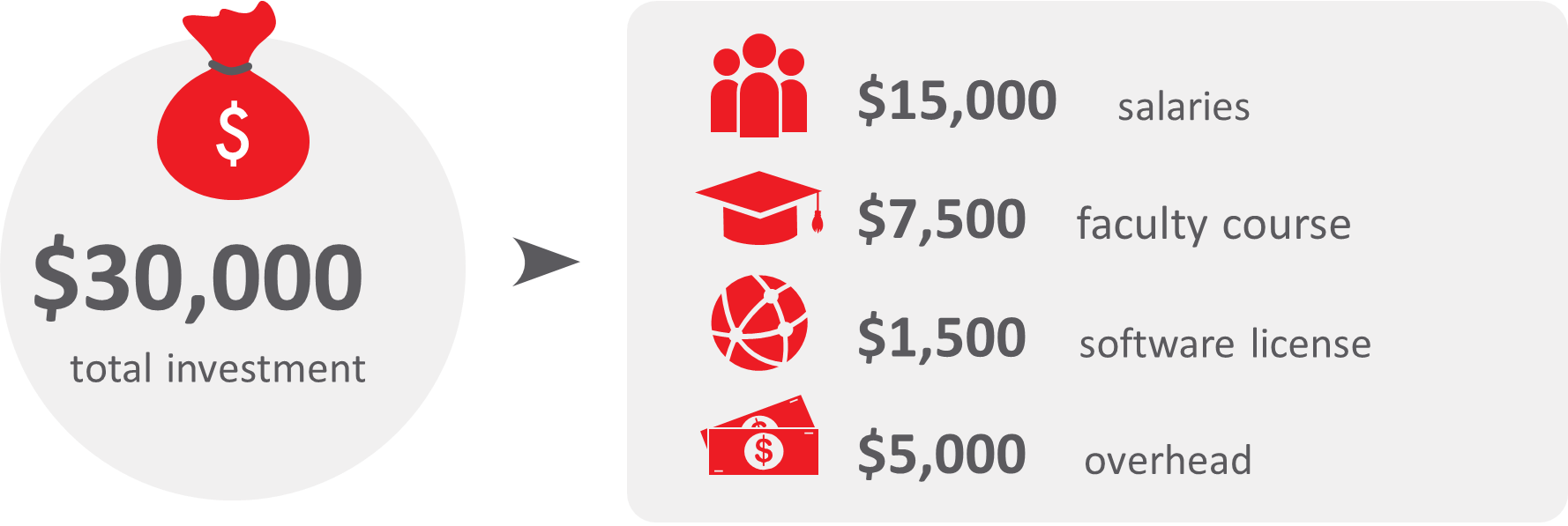
 Negotiate the applied research agreement
Negotiate the applied research agreement
The college drafted a mutually-acceptable research agreement which outlined project scope, activities, budget, schedule, intellectual property considerations, confidentiality, publication rights, indemnity, payment terms, key contacts, etc.
Once it was determined that the manufacturer met NSERC’s eligibility requirements, the college successfully applied to NSERC for a research partnership grant to help defray project costs. NSERC awarded $25,000 to the college to perform the applied research. Since the total project cost was $30,000 the company was required to contribute an additional $5,000.
 Respond to/work with the college team
Respond to/work with the college team
The NSERC grant was used for the salaries of both the student research assistant and research professional, one course release for the faculty member, a software license and overhead. The manufacturer provided all the product components, any available specifications and drawings, and cash funding equivalent to 20% of the NSERC grant. The terms of the NSERC grant gave the manufacturer ownership of the resultant intellectual property; the project research agreement granted the college the right to use the results for further research and education, publication (after review by the manufacturer) and the student the right to mention their involvement on their resume.
Over a four-month period, the TAC used specialized laser inspection technology to “reverse engineer” the individual components, prepare a three-dimensional (3D) model and new detailed blueprints. The manufacturer collaborated on the development of the 3D model, as well as the parameters necessary for advanced simulation modelling of product performance. Project deliverables included the 3D model, complete blueprints, and a final report detailing the work carried out (including a finalized optimum design, based on the results of the simulation).
 Assess/Evaluate/Implement applied research results
Assess/Evaluate/Implement applied research results
The manufacturer incorporated the results and is producing a product with increased capacity and improved performance. Manufacturing is more efficient, quality is better, sales and their return on investment are increased.
And, since employees come and go for a variety of reasons, the availability of a fully documented (now digital) design of a key product provided the necessary information to better train new employees – both on the shop floor and in the engineering department.
The project was eventually deemed (by the Canada Revenue Agency) to be SR&ED eligible5.
Future work is planned for extreme climatic testing of new product design prototypes at the college.
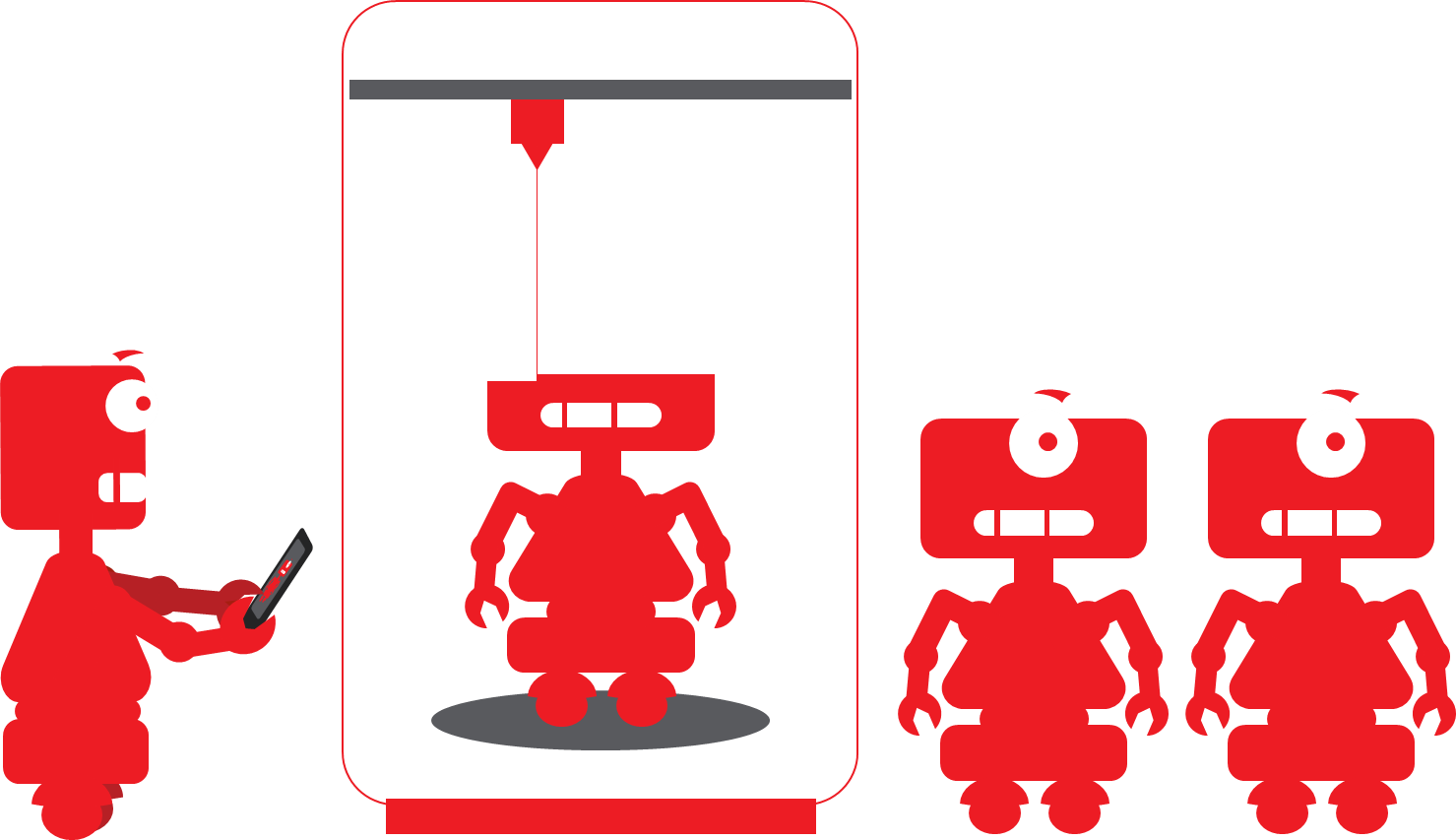
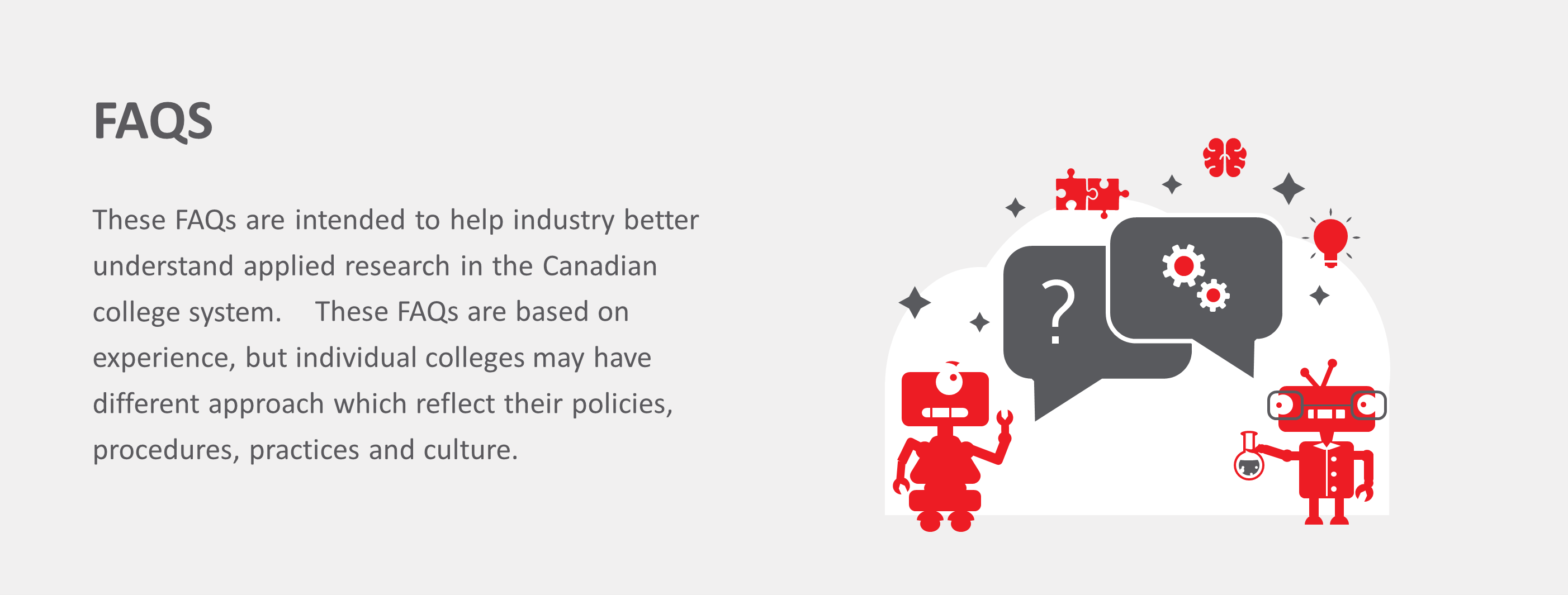
- What is the best way to contact a college about an applied research need?
Each college will have for a unit responsible for applied research and innovation which can put potential clients in touch with the right individual at the College to discuss the specific industry challenge or need.
Alternatively, Tech-Access Canada’s JumpBall program6 taps into the innovative capacity and capabilities of the network of Canada’s 60 Technology Access Centres. The inquiry form enables a company to provide as much detail as they are willing to share. interested TACs across Canada will review the inquiry and Tech-Access Canada will promptly provide a curated list of TACs who have volunteered to assist, as well as their points of contact.
Local industry associations or an Industrial Technology Advisor from the National Research Council Industrial Research Assistance Program can also help industry to identify an appropriate college contact.
- Are there public sources to find a college with the right applied research equipment, facilities and/or expertise?
Yes. The Canada Foundation for Innovation (CFI) manages an online Research Navigator7 tool which enables searches of Canadian research facilities.
Alternatively, Tech-Access Canada’s JumpBall Initiative mentioned in FAQ 1 can connect industry to the appropriate service provider with Canada’s TACs.
- What if the college cannot undertake the applied research project?
Colleges have close connections to all players in the regional innovation ecosystem. College applied research offices will often refer potential clients to other organizations – in either the public or private sector – which may be able to assist.
It should be noted that colleges will not, unless there are exceptional circumstances, accept routine assignments (for example, build to print). Colleges want to add value and will only take on challenges with an innovative solution. Routine work and off-the-shelf testing are the domain of the private sector.
- How is an applied research project initiated?
Once the client and college are connected, the first step is to mutually discuss/clarify the specific need. Then, the college will determine the available expertise and equipment. A statement-of-work will then be developed to set out the scope, work to be done, deliverables, schedule and budget. This statement-of-work will then become the basis for an agreement to move forward on the project, including the necessary terms and conditions.
- Is there a lot of paperwork involved to initiate an applied research project?
No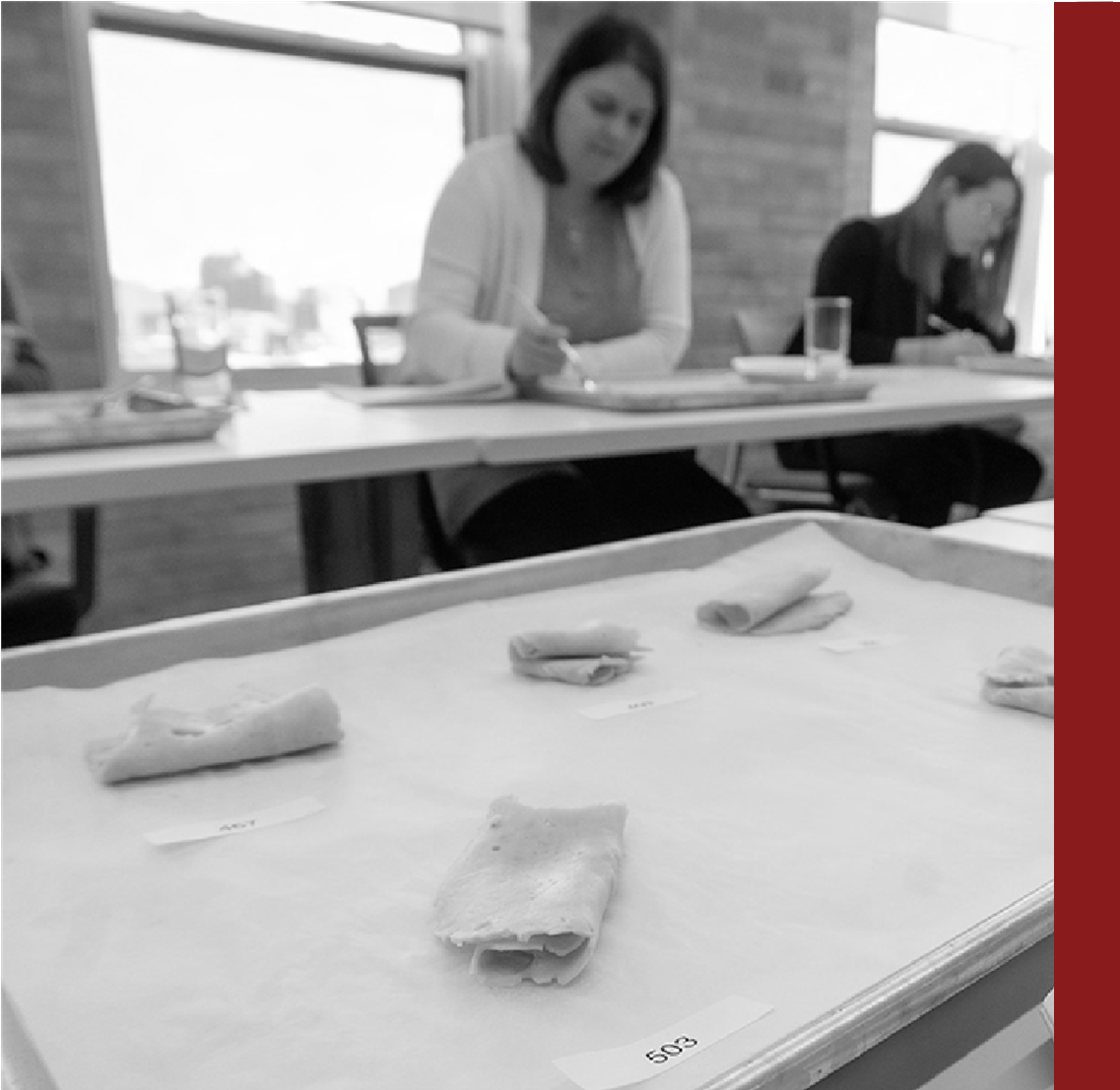 n-Disclosure Agreement is often part of the project initiation process, to protect both the client and the college. The college will have standard applied research agreements as a starting point for negotiations. These agreements typically address the statementof-work (scope, deliverables, budget, schedule etc.), intellectual property, confidentiality, publications, indemnification, insurance, contacts etc.
n-Disclosure Agreement is often part of the project initiation process, to protect both the client and the college. The college will have standard applied research agreements as a starting point for negotiations. These agreements typically address the statementof-work (scope, deliverables, budget, schedule etc.), intellectual property, confidentiality, publications, indemnification, insurance, contacts etc.
Depending upon the nature of the need (for example, a technical service which requires use of specialized equipment or facilities), a quote by the college and a purchase order from the client may be sufficient.
- Who will be working on the applied research project?
There are generally three options – faculty, students and research professionals (such as technicians, technologists, engineers, scientists and other practitioners skilled in their field). The services of qualified and competent independent contractors may also be engaged to assist the college team. The research office will also be engaged in project management and administration. The client can trust the college to assemble the correct multi-disciplinary team to solve their innovation challenge.
The client will be expected to identify a key contact to liaise/work with the applied research team, as needed.
- Are positive results guaranteed/is there a warranty on the work/deliverable/final product?
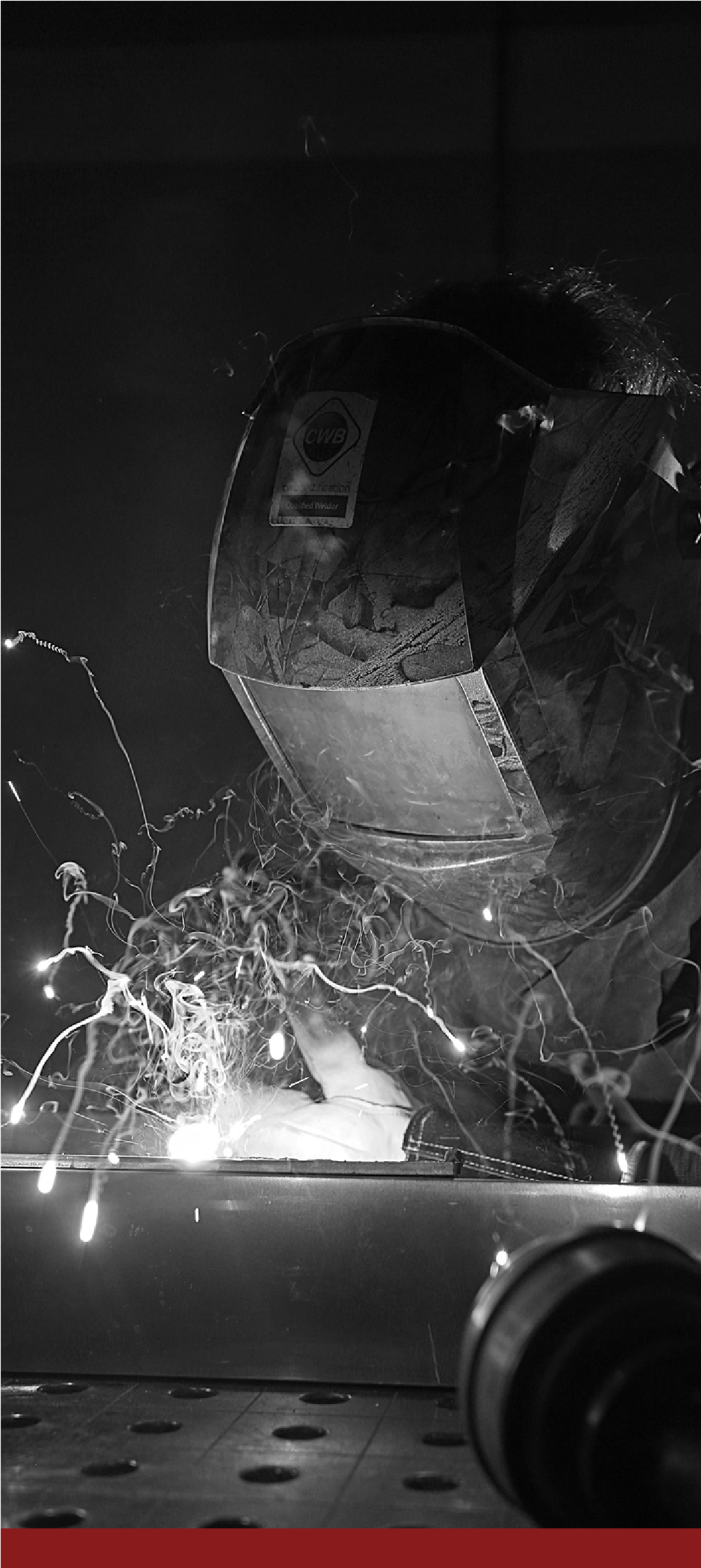 No. Applied research projects are carried out on a “best effort” basis, there is no guarantee or warranty of outcomes and results (especially positive results). Applied research agreements include terms and conditions in this regard.
No. Applied research projects are carried out on a “best effort” basis, there is no guarantee or warranty of outcomes and results (especially positive results). Applied research agreements include terms and conditions in this regard.
The reality is, despite the best efforts of the multi-disciplinary teams, sometimes applied research projects “fail”. Perhaps the solution isn’t technologically feasible, not commercially viable, or over the course of the project, it emerges that the client is unintentionally infringing on someone else’s Intellectual Property.
- Do applied research projects ever fail?
YES. Not achieving a hoped-for result or “failure” can occur.
A negative result – for example, one which shows more work is required – should not necessarily be considered unfavourable. An early “failure” may result in reallocation of industry resources to other products, processes or services which may get to market sooner.
- What are the qualifications of college personnel working on the applied research project?
Participating faculty members will have expertise in the project focus area; while students will have an appropriate or relevant education and technical background, albeit likely with less experience. Professional research staff (PhDs, Master’s, P. Eng. etc.) will know how to operate the necessary research equipment and/or have the business or technical knowledge to contribute to developing the solution to the challenge.
- What rights do students have when working on an applied research project?
When students are hired to work on the project, they should be considered as employees of the college and would be subject to the same expectations as other college employees. This includes the provisions of a Non-Disclosure Agreement.
If the project is also funded by a third party, such as a granting agency or council, the students often will have the right to indicate on their resumes that they worked on the project. And their graduation cannot be delayed, especially if their efforts are part of their graduation project or thesis.
Third party funding conditions will vary by the different funding organizations.
Students may also participate in projects on an unpaid basis, often as part of a class project or a work-integrated-learning experience. In these cases, the industry challenge should be a “back burner” project – one that the company does not always have the time or resources to address. In this situation, student rights need to be discussed with the college upfront.
- Can an applied research client hire students who worked on the applied research project?
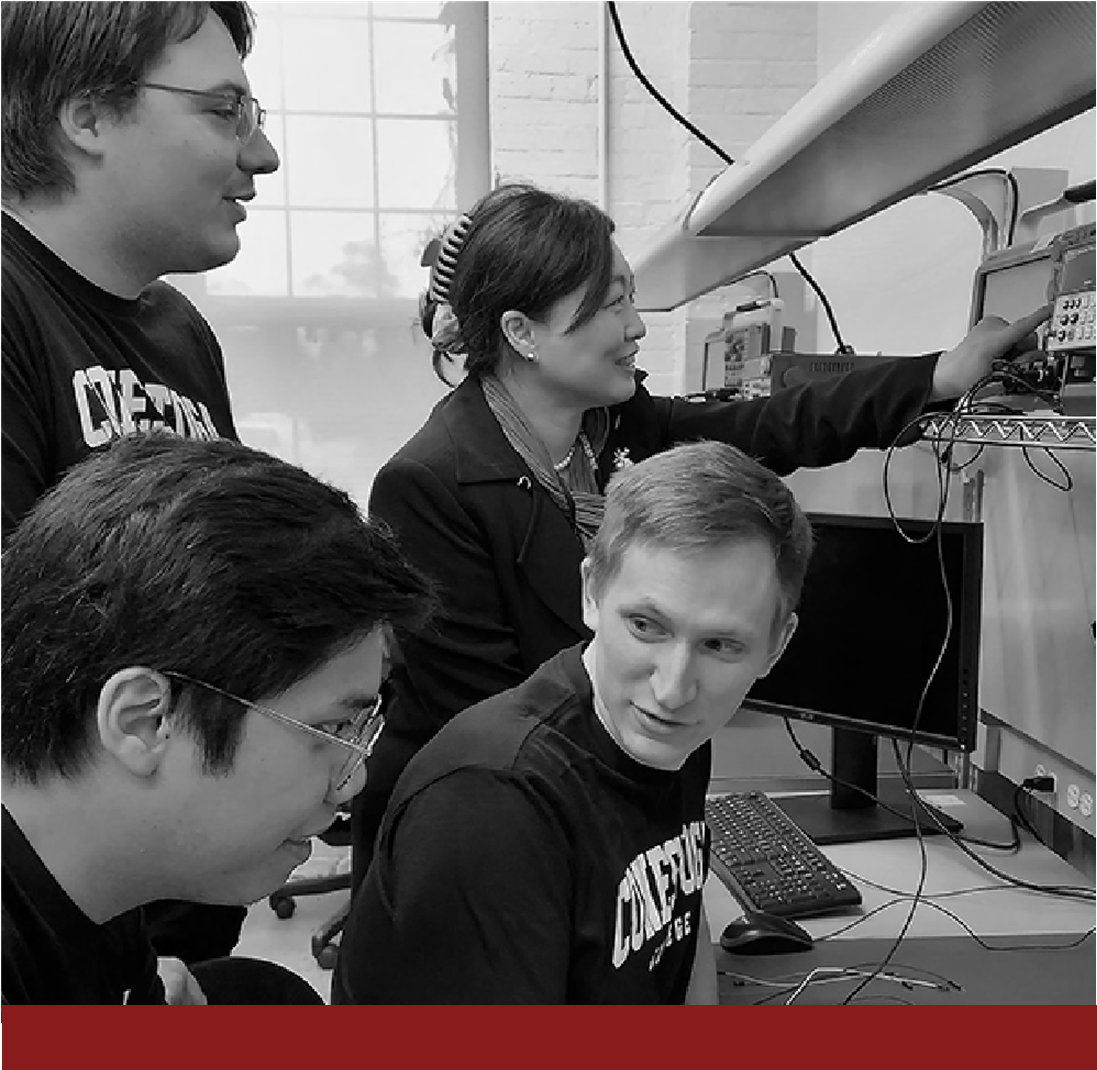 YES. While students can be hired at any time, student are most often hired, upon their graduation, after completion of an applied research project.
YES. While students can be hired at any time, student are most often hired, upon their graduation, after completion of an applied research project.
Applied research projects – including those involving class projects and work placements – are a good way to evaluate potential future employees (and for the students to get to know the future employers)..
- What will the applied research project cost?
Colleges often undertake applied research on a direct cost recovery basis. In addition to the cost of salaries and benefits of research personnel, materials, supplies, consumables, and equipment and/or facility use are typical line items. Overhead may also be charged.
A “typical” $25,000 project may see a budget allocation such as:
- Salaries: $7,500.
- Course Release: $7,500.
- Materials & Supplies: $3,000.
- Facility Utilization: $2,000.
- Overhead: $5,000.
- Why does the client have to pay for the salaries of college faculty, research staff and students?
College faculty are employed to teach and are typically not funded by the province to do research. If you take an instructor out of the classroom for a research project, you need to backfill the position. Therefore, applied research is undertaken on an as-available basis and the cost of the faculty member is often addressed through a fee for “course release” which is then used to pay for a teaching replacement.
Colleges are expected to recover the salary costs of research staff and any students hired to work on a project. These costs may be offset, to some degree, by third party funding from public research funding organizations and agencies.
- Who pays for, or provides, any necessary applied research project supplies and materials?
The industry client is responsible for providing or paying for supplies and materials, in the absence of a third-party funder.
- Is there a charge for the use of specialized research equipment and facilities?
YES. Industry clients can expect to be charged fees, on either a one-time or utilization time basis. Colleges often have standard rates, which should include the time of skilled and qualified personnel who will safely and properly operate the specialized equipment and facilities.
- Can research equipment and/or facilities be rented, and the renter allowed to do their research in private?
Utilization of research equipment and/or facilities often requires qualified and skilled personnel, who have been also trained and meet the college’s workplace health and safety requirements. There are also facility access and security considerations, especially after regular operating hours, as well as potential liability concerns. Finally, as educational institutions, applied research activities would normally be expected to involve faculty or students in some manner.
Therefore, barring exceptional circumstances, such “rentals” and “private” research would be highly unlikely.
- What is overhead and why is it being charged?
Normally overhead is charged in order to recover indirect costs of research such as utilities, security, operations and maintenance, repairs and upgrades.
Individual colleges MAY waive overhead to assist SMEs.
18.Is there government funding available to subsidize an industry applied research project?
YES. The Government of Canada, as well as many of the Provinces and/or Territories, have many programs to provide support for industry applied research.
Colleges most often utilize programs from the “Tri-Council”, i.e., NSERC, SSHRC and CIHR; and also apply to programs such as Mitacs (for student support). Colleges typically prepare the relevant research funding proposal. In general, the more funding is requested, the longer the approval turnaround time (weeks to months) from the funding agency. Funding will flow to the college, not the industry client, to carry out the project. Each funder will governing their own requirements for use of their funding, what is an eligible cost, etc. These funding awards typically go to the college and not the industry client.
Colleges and select non-profit organizations (such as Tech-Access Canada) have contribution agreements with organizations such as NRC IRAP which enable the provision of technical or business support for qualified industry clients, especially SMEs.
Companies can also apply to programs (such as NRC IRAP) for financial support which, in turn, can be used for applied research projects with the post-secondary sector.
Industry support for applied research is also available through tax credits such as the SR&ED program.
- What determines eligibility for government funding to carry out applied research at a college?
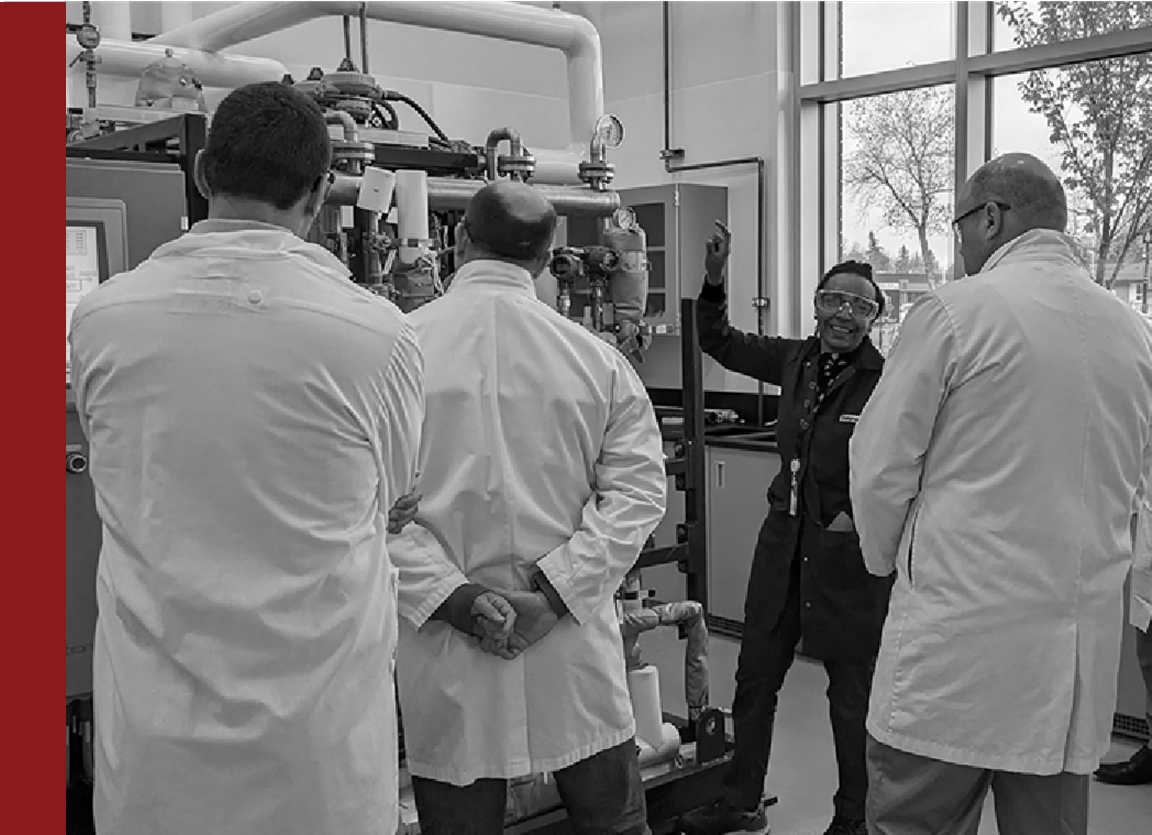
Eligibility for government funding is determined by the funder, in accordance with their specific funding program requirements. Eligibility varies significantly from program to program and can be very fru
strating to navigate. The college applied research office can assist with this and are able to recommend the most industry-friendly programs.
20.Isn’t a college competing unfairly with the private sector when undertaking an applied research project?
No. Knowledge, expertise and specialized research equipment and facilities – of interest to industry – are often found in colleges which will undertake applied research to add value to industry clients seeking to bring a new product, process or service to market.
Activities such as “routine” R&D, “build to print” and ongoing quality assurance of production parts are neither desired nor sought after by colleges; especially if there is a potential private sector provider available in the region. Without a novel aspect to the engagement, unless there are extenuating circumstances (such as availability or capacity to respond to a time-sensitive requirement), Colleges will refuse off-the-shelf services and direct clients to a private sector service provider able to address their needs.
- When can the applied research project begin?
It depends. Availability is linked to capacity. The timing of project commencement will primarily depend upon the availability of college personnel, delays may occur if timing coincidences with academic terms (especially when the college’s educational programs restart in the fall and winter). However, with enough lead time, potential conflicts with educational programs can be managed.
Access to specialized facilities can sometimes be a challenge but can often be accommodated by utilizing at off-peak times.
Delays can also occur as the result of the procurement process (especially for specialized components and equipment), access to industry client-supplied resources (such as materials, facilities, personnel), plant shutdowns, supply chain delays, shipping regulations and restrictions etc.
- What is the timeline for doing the applied research project?
It varies. The timeline depends upon the scope and nature of the applied research and availability of all needed resources (from the college and the industry client). Good project management is essential.
23. How much time is expected from the industry client to work with a college on an applied research project?
Depending upon the scope and nature of the applied research, time commitments from the industry client can range from minimal to full-time participation on the project team.
Regular, effective communication and documenting key decisions will help to ensure that the time (of all participants) is efficiently utilized and properly managed. It is essential that the college and company work closely together to ensure the problem is properly understood, this will add the most value to the solution.
24. Once an applied research project is initiated can the industry client simply walk away and come back for the results when the project is completed? What are the deliverables from an applied research project?
NO. This is not recommended, since regular and ongoing interaction between the industry
client and the college is essential to address any potential changes in scope or direction,
unexpected issues, to answer any questions (from either party) which may arise, etc.
25. What are the deliverables from an applied research project?
Deliverables can include items such as drawings, prototypes, test procedures, test results and
reports (including progress reports).
- Can payments for applied research be deferred?
Payment terms should always be negotiated, up front.
The research agreement will have a payment schedule wich will address the down payment
(often due upon signing), any progress payments and sometimes a holdback payment (holdback with respect to acceptance of the Deliverables, nothing to do with the research results).
If deferment of payments, for example until commercialization proceeds are available, are requested; the granting of deferred payments would be at the discretion of the college (especially if the college is incurring direct costs for the project which may not otherwise be recoverable).
- What happens if the industry client cannot pay their invoice for the project?
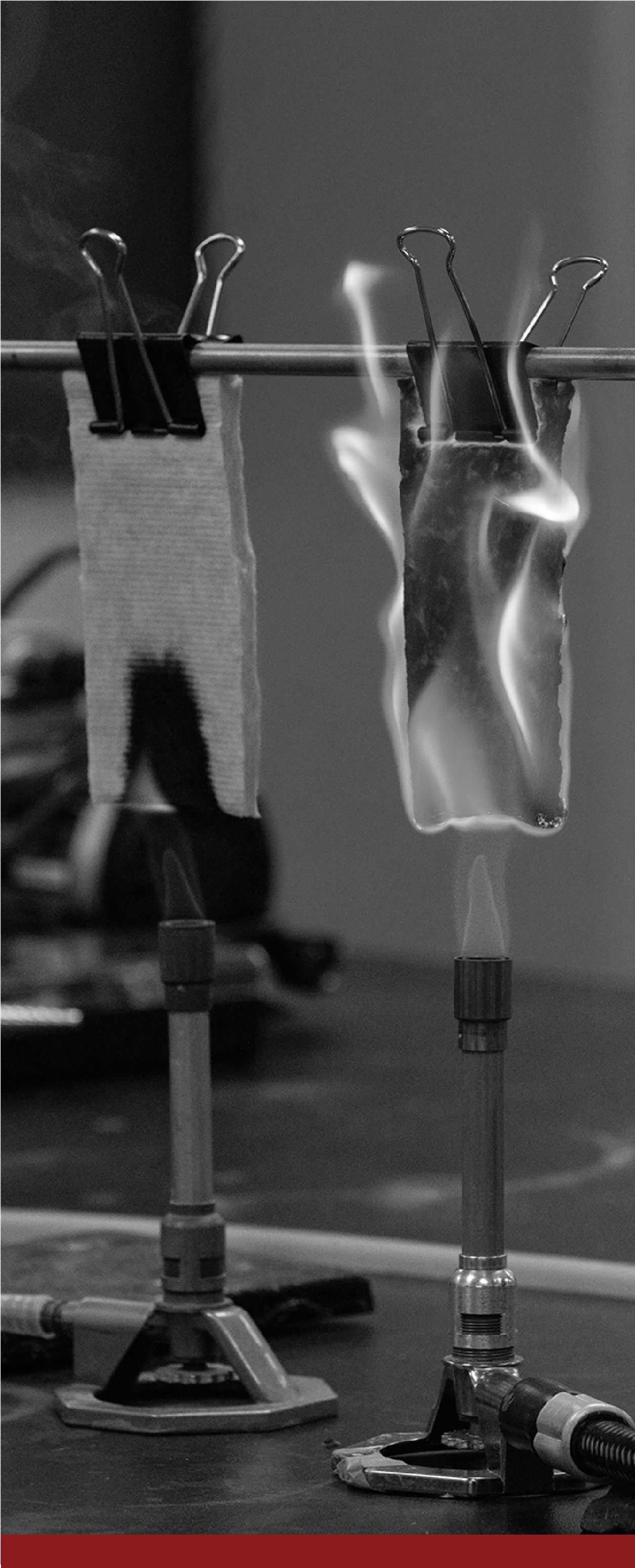 If non-payment becomes an issue, as a first step, the applied research department will often attempt to work with the client to see what is possible with respect to payment arrangements. Deliverables will likely be withheld, unless they have already been provided by the college to the industry client.
If non-payment becomes an issue, as a first step, the applied research department will often attempt to work with the client to see what is possible with respect to payment arrangements. Deliverables will likely be withheld, unless they have already been provided by the college to the industry client.
In the event the project has also received government or third-party funding, the college will notify the appropriate funding organization – this will likely have adverse effects on any potential future funding requests involving the industry client.
If payment arrangements cannot be sorted out, or if the client is nonresponsive, then the college’s finance department will take the necessary steps to arrange payment – up to, and including, assignment of the debt to a collection agency.
- What types of applied research projects are the college unwilling to take on?
A college will not take on an applied research project for which neither the expertise nor specialized research equipment/facilities are unavailable.
If the project is one which could be done by the private sector (assuming the private sector has access to the appropriate knowledge, expertise and specialized equipment/facilities), colleges will normally decline.
Technical services such as routine testing (for example, to determine material properties) or “build-to-print” projects would normally be referred to the private sector, unless they are part of the scope of an R&D project.
Quality assurance activities, on a production basis, would be declined. Quality assurance activities by the college would be done on prototypes and/or limited pre-production runs (for example, to produce a small quantity of items for testing, evaluation or demonstration purposes).
Colleges will not undertake projects which are unethical. The college will have access to a Research Ethics Board which will make the determination regarding whether or not the project complies with the college’s research ethics policy and requirements.
Projects which disregard any funder requirements will be declined.
Applied research projects which involve illegal activities will not be undertaken.
- Are there potential clients with which the college is not prepared to work?
The college will work with Industry clients which are legal business entities8 – such as corporations, partnerships and soles and proprietorships. The college will also work with other organizations such as cooperatives, not-for-profits, industry associations, producer groups and foreign companies.
 Individuals (for example, inventors with an idea) may not meet the eligibility requirements (such as being incorporated, a minimum number of employees or a minimum amount of time in business) of potential third-party funders. None-the-less, colleges can often still assist.
Individuals (for example, inventors with an idea) may not meet the eligibility requirements (such as being incorporated, a minimum number of employees or a minimum amount of time in business) of potential third-party funders. None-the-less, colleges can often still assist.
And as long as the nature of the applied research project is legal within that jurisdiction, the college would be in a position to accept it.
It should be noted that colleges are NOT compelled to work with any organization or individual.
- Can a college also provide business advice?
YES. Colleges, often with the support of third-party organizations, are able to provide limited business- and market-intelligence related advice as a service to an industry sector. Students, as part of their studies, may assist with business planning, market studies etc.
- Who owns the intellectual property arising from the applied research project?
Ownership of intellectual property/access to commercial rights resulting from college applied research is typically granted on a royalty-free basis to the industry client.
There are many forms of intellectual property protection9 – including patents, copyright, trademarks and trade secrets. If intellectual property protection is required (e.g., a patent) this would typically be undertaken, and ultimately paid for, by the industry client.
The college will typically retain rights for further research and education purposes.
A recent survey by the Ontario College Employer Council10 included a comment which stated, “we believe that the Province is better served when the public sector research institutions support the commercial success of our partners rather than engaging in licensing or seeking to control the IP”.
- Will proprietary information be kept confidential?
College applied research departments will normally treat information on a confidential basis – unless advised otherwise. However, it is still a good strategy to only disclose proprietary information when, and if, necessary.
Non-Disclosure Agreements (which typically apply to all those employed by the college to work on the project) are often used in applied research project negotiations, while applied research agreements will address confidentiality and any related publication rights.
- Will competitors know about the applied research project and related details?
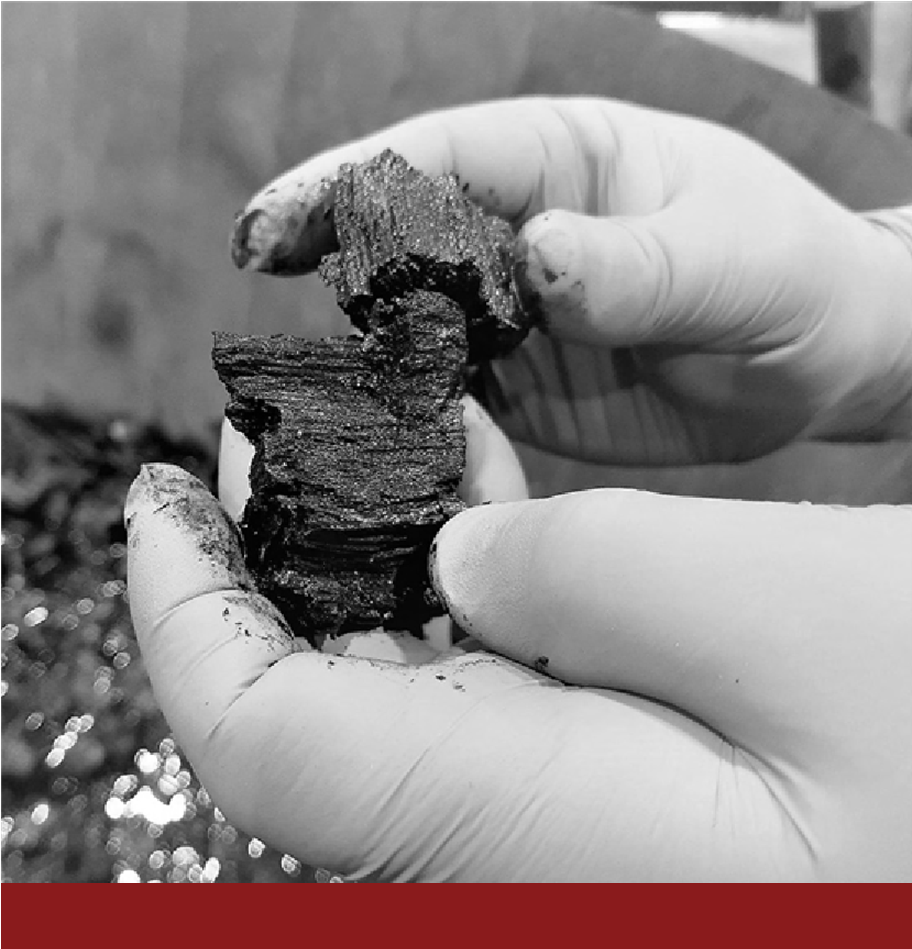 Third party funders (such as NSERC) will publish information concerning research funding awards, i.e., that a grant was awarded for a specific project involving the college and industry client, often with a brief abstract of the projects. These summaries do not contain proprietary or confidential material.
Third party funders (such as NSERC) will publish information concerning research funding awards, i.e., that a grant was awarded for a specific project involving the college and industry client, often with a brief abstract of the projects. These summaries do not contain proprietary or confidential material.
The college will be governed by the terms of any NDAs, the applied research agreement and any terms and conditions dictated by third party funders.
- Will the college publish the results of the applied research project?
Normally, a college will consult with the industry client – including the right to a time-limited review of a proposed publication to ensure no proprietary information is disclosed – prior to any potential publication.
Publication rights should be addressed in the applied research agreement.
- Will the applied research project be SR&ED-eligible?
While there are no guarantees with respect to eligibility for tax system-related programs, including tax credits, when a Canadian company undertakes a research project with a postsecondary institution, the projects are normally considered eligible for the SR&ED program.
If funding has been secured from a government funding agency (especially one such as NSERC), and that project proposal has gone under the peer review process, then that normally also is a good indicator of SR&ED eligibility.
ACRONYMS
 3D: 3-Dimensional
3D: 3-Dimensional
CAD: Computer Aided Design
CFI: Canada Foundation for Innovation
CIHR: Canadian Institutes of Health Research
CTO: Contribution to Organization
FAQ: Frequently Asked Question
IP: Intellectual Property
IRAP: Industrial Research Assistance Program
ITA: Industrial Technology Advisor
NDA: Non-Disclosure Agreement
NRC: National Research Council of Canada
NSERC: Natural Sciences and Engineering Research Council of Canada
R&D: Research and Development
SME: Small- and Medium-sized Enterprise
SR&ED: Scientific Research and Experimental Development
SSHRC: Social Sciences and Humanities Research Council
TAC: Technology Access Centre
PHOTOS CREDITS
| PHOTOGRAPHER | TAC | PAGE |
| Leigh Kovesy | TACSSI | 1 |
| Ben Quaiff | CNPMC | 2 |
| Yves Gervais | TAC-B | 3 |
| Leigh Kovesy | TACSSI | 3 |
| Jeffrey Langlois | Nergica | 4 |
| Elena Battle | NBDC | 5 |
| Sachin Pundir | TACSSI | 6 |
| Leigh Kovesy | TACSSI | 7 |
| Sachin Pundir | TACSSI | 8 |
| Adrienne Montgomery | CSK | 9 |
| Martin Toulgoat | Merinov | 10 |
| Anna Borys | PRK | 11 |
| Sachin Pundir | TACSSI | 13 |
| Anna Borys | PRK | 19 |
| Adam | CSM | 20 |
| Samantha Jorge | SMART | 22 |
| Monica Franco Herrera | TACOSS | 24 |
| Sarah-Jeanne Magny | Innofibre | 27 |
| Joshua McGurk | EPIC | 28 |
| Hélène Cajolet-Boisclair | Agrinova – Biochar | 30 |
| Yves Gervais | TAC-B | 30 |
| Ben Quaiff | CNPMC | 31 |
| Jeffrey Langlois | Nergica | 34 |
BIBLIOGRAPHY
- eCampusOntario: Developing innovation and collaboration in Ontario’s postsecondary institutions. https://www.ecampusontario.ca/
- Tech-Access Canada is a national, not-for-profit organization passionate about expanding the reach of its member Technology Access Centres (TACs). https://tech-access.ca/
- Results from the NSERC’s Awards Database (https://www.nserc-crsng.gc.ca/ase-oro/index_eng. asp?new), January 28, 2022.
- The Scientific Research and Experimental Development (SR&ED) tax incentives are intended to encourage businesses to conduct research and development in Canada. https://www.canada. ca/en/revenue-agency/services/scientific-research-experimental-development-tax-incentiveprogram.html
- Reporting of SR&ED expenditures is required within 12 months after the company’s business income tax return is due for the year in which the expenditure occurred https://www.canada. ca/en/revenue-agency/services/scientific-research-experimental-development-tax-incentiveprogram/filing-requirements-policy.html#toc14.
- Tech-Access Canada’s Jump Ball Initiative (JBI) taps into the innovative capacity and capabilities of the network of Canada’s Technology Access Centres, including over 2,000 business innovation experts and almost 4 million square feet of dedicated applied research space. https://tacjumpball.ca/JumpBall/Create
- CFI’s Research Facilities Navigator: Find research facilities in universities, colleges, hospitals, and federal government departments and agencies across Canada that are open to working with you on your research and innovation needs. https://navigator.innovation.ca/en
- Canada Revenue Agency: Setting up your business. https://www.canada.ca/en/revenue-agency/services/tax/businesses/small-businesses-self-employed-income/setting-your-business.html.
- Canadian Intellectual Property Office: Understand the basics – What are intellectual assets? https://www.ic.gc.ca/eic/siTe/cipointernet-internetopic.nsf/eng/wr03585.html.
- Ontario College Intellectual Property Survey Report. Public Report Summary for the College Employer Council by NEXUS Manitoba. May 2021.



